配置mybatis
maven:
<dependency>
<groupId>mysql</groupId>
<artifactId>mysql-connector-java</artifactId>
<scope>runtime</scope>
</dependency>
<dependency>
<groupId>org.mybatis.spring.boot</groupId>
<artifactId>mybatis-spring-boot-starter</artifactId>
<version>2.0.0</version>
</dependency>application.yml:
server:
datasource:
driver-class-name: com.mysql.cj.jdbc.Driver
url: jdbc:mysql://localhost:3306/mybatisstu?useUnicode=true&characterEncoding=utf8&useSSL=false&serverTimezone=UTC&allowPublicKeyRetrieval=true
username: root
password: 123456
mybatis: #mybatis配置
mapper-locations: classpath:mapper/*.xml
type-aliases-package: com.fen.dou.entity
config-location: classpath:config/mybatis.xmlclasspath:config/mybatis.xml 其中 <setting name="logImpl" value="STDOUT_LOGGING"/>打印执行sql
<?xml version="1.0" encoding="UTF-8"?>
<!DOCTYPE configuration
PUBLIC "-//mybatis.org//DTD Config 3.0//EN"
"http://mybatis.org/dtd/mybatis-3-config.dtd">
<configuration>
<settings>
<setting name="logImpl" value="STDOUT_LOGGING"/>
</settings>
</configuration>一级缓存
一级缓存作用在同一个sqlSession内的,是默认开启的,添加事务才会生效,一个事务内及一个业务逻辑之内应该不会重复去读取事务(跟可重复读事务相匹配,不会产生脏数据,如果为读未提交和读已提交事务,则会产生脏数据),所以没必要有一级缓存
@Override
@Transactional
public User findUser() {
userMapper.findUser();
userMapper.findUser();
return userMapper.findUser();
}import com.fen.dou.Application;
import com.fen.dou.service.IProductService;
import com.fen.dou.service.IUserService;
import org.junit.Test;
import org.junit.runner.RunWith;
import org.springframework.beans.factory.annotation.Autowired;
import org.springframework.boot.test.context.SpringBootTest;
import org.springframework.test.context.junit4.SpringRunner;
@RunWith(SpringRunner.class)
@SpringBootTest(classes = {Application.class})
public class TestJunit {
@Autowired
private IUserService userService;
@Test
public void testSay() throws Exception {
userService.findUser();
}
}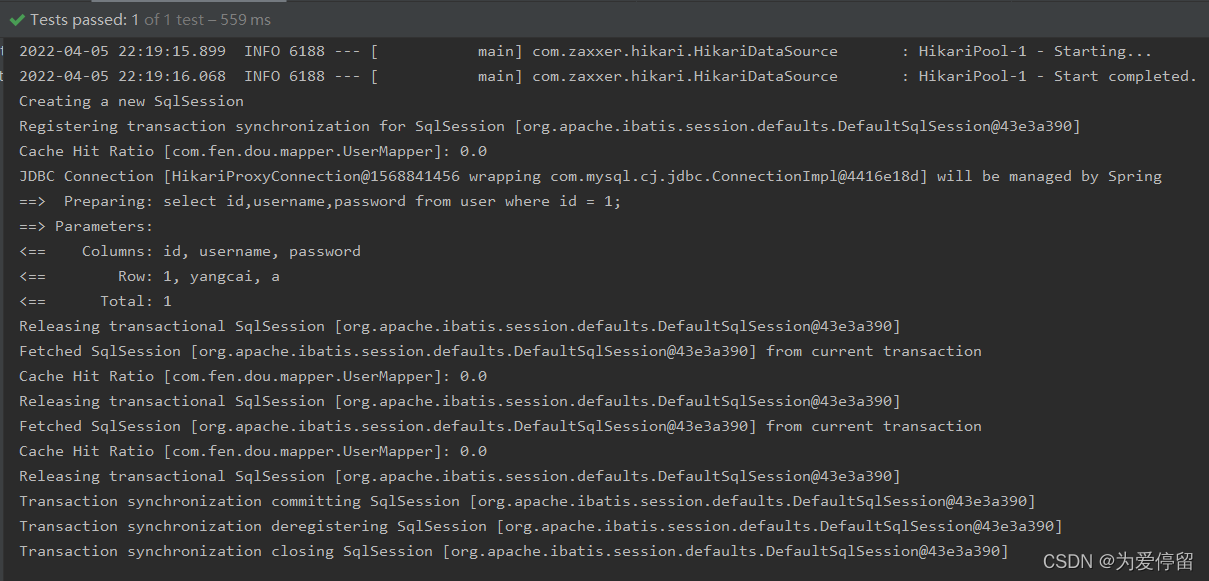
在一个事务内,多次读取数据只会查询一次数据库
二级缓存
二级缓存作用的在同一个mapper作用域下,需手动开启,一个mapper对应的缓存,多个sqlSession可以共享
手动配置:
1、配置<setting name="cacheEnabled" value="true" />
<?xml version="1.0" encoding="UTF-8"?>
<!DOCTYPE configuration
PUBLIC "-//mybatis.org//DTD Config 3.0//EN"
"http://mybatis.org/dtd/mybatis-3-config.dtd">
<configuration>
<settings>
<setting name="logImpl" value="STDOUT_LOGGING"/>
</settings>
<setting name="cacheEnabled" value="true" />
</configuration>2、需要在二级缓存生效的mapper中配置:<cache></cache>
<?xml version="1.0" encoding="UTF-8"?>
<!DOCTYPE mapper PUBLIC "-//mybatis.org//DTD Mapper 3.0//EN" "http://mybatis.org/dtd/mybatis-3-mapper.dtd">
<mapper namespace="com.fen.dou.mapper.ProductMapper">
<cache></cache>
<select id="selectCountById" parameterType="int" resultType="int">
select `count` from product where id=#{productId}
</select>
<update id="reduceCount" parameterType="map">
UPDATE product SET count=count-1 WHERE id=1;
</update>
</mapper><?xml version="1.0" encoding="UTF-8" ?>
<!DOCTYPE mapper
PUBLIC "-//mybatis.org//DTD Mapper 3.0//EN"
"http://mybatis.org/dtd/mybatis-3-mapper.dtd">
<mapper namespace="com.fen.dou.mapper.UserMapper">
<cache></cache>
<resultMap id="ResultMap" type="com.fen.dou.entity.User">
<id column="id" property="id" />
</resultMap>
<resultMap id="ResultMap1" type="com.fen.dou.entity.UserVo">
</resultMap>
<select id="findUser" resultMap="ResultMap">
select id,username,password from user where id = 1;
</select>
<update id="updateUser" >
update user set username = 'yangcai' where id = 1
</update>
<select id="findUserProduct" resultMap="ResultMap1" useCache="false">
select product.count,username,password from user left join product on user.id = product.userId where user.id = 1;
</select>
</mapper>3、需要在sql返回结果的实体中添加序列化
@Data
public class UserVo implements Serializable {
private Integer count;
private String username;
private String password;
}@Data
public class User implements Serializable {
private Integer id;
private String username;
private String password;
public User(Integer id, String username, String password) {
this.id = id;
this.username = username;
this.password = password;
}
}现在来测试二级缓存
@GetMapping(value = "/test1")
public User test1(){
return this.userService.findUser();
} <select id="findUser" resultMap="ResultMap">
select id,username,password from user where id = 1;
</select>

请求两次, 两个会话只查询了一次
当执行关联表的sql
@GetMapping(value = "/test2")
public UserVo test5(){
return this.userService.findUserProduct();
} <select id="findUserProduct" resultMap="ResultMap1">
select product.count,username,password from user left join product on user.id = product.userId where user.id = 1;
</select>
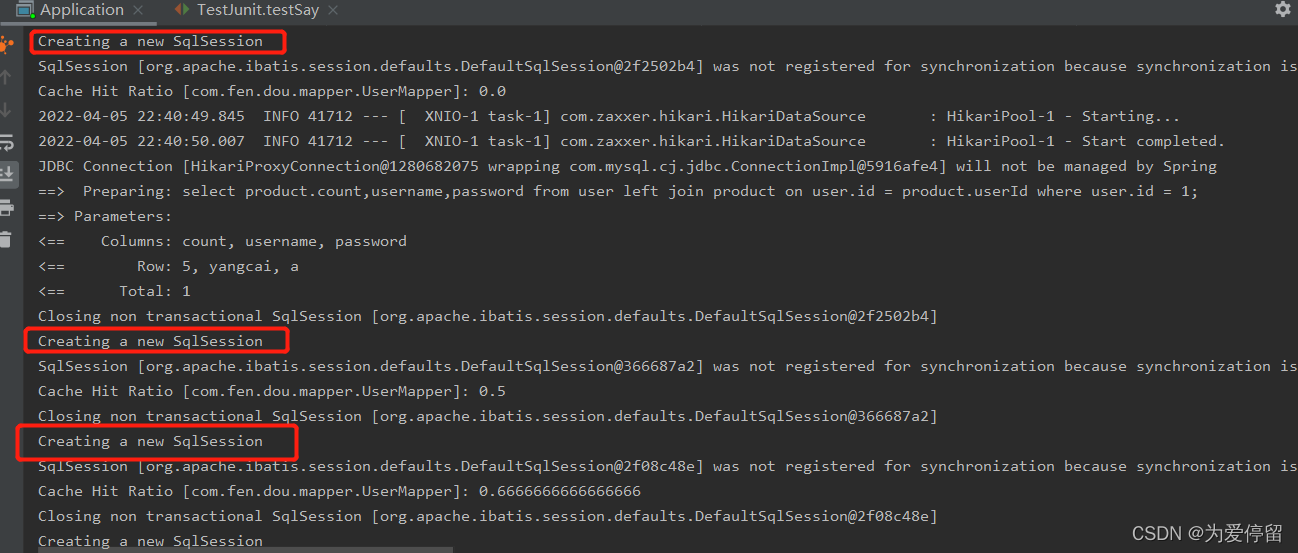
这个缓存作用在userMapper作用域下,此时数据库中的count的值确实是5
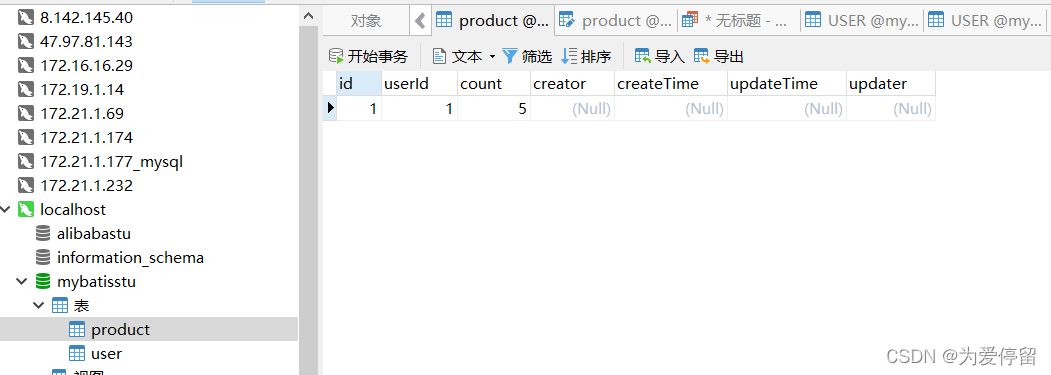
当我在productMapper作用域下更新count值
@GetMapping(value = "/update1")
public void test3() throws Exception {
this.productService.reduceCount(1,1);
} <update id="reduceCount" parameterType="map">
UPDATE product SET count=count-1 WHERE id=1;
</update>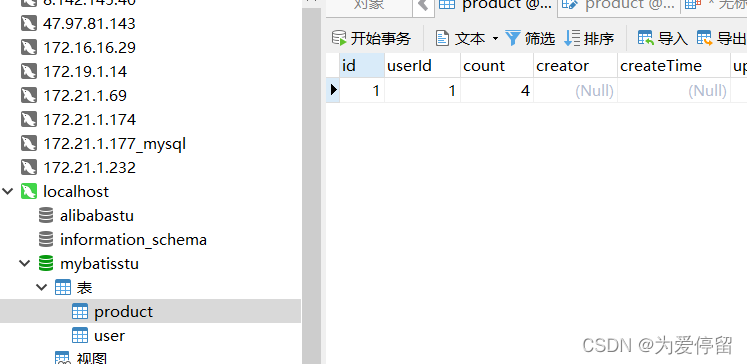
数据库中的值变成4了,再次请求http://localhost:8080/test2,count的值仍然是5,造成数据不一致了(数据库和缓存的数据不相同)
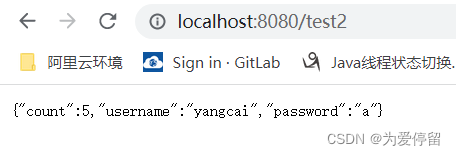
所以,这个sql不能生成二级缓存,否则会造成数据不一致,可以对一个mapper下单个查询设置不生成二级缓存,配置 useCache="false",则每次都是从数据库里面去查询数据
<select id="findUserProduct" resultMap="ResultMap1" useCache="false">
select product.count,username,password from user left join product on user.id = product.userId where user.id = 1;
</select>二级缓存对单表查询可以设置设置二级缓存,对多表联合查询,需要禁止开启二级缓存,否则会造成数据不一致